Top Skills in Demand by Occupation Group
The skills employers look for the most vary by type of occupation. There are also skills employers look for across all occupations. The charts list skills and certifications relevant to the occupational category. Skills are grouped as:
- Occupational Skills - skills learned on the job or through training
- Social-economical - cognitive, interpersonal, language, resource management, and personal qualities
- Tools and Equipment – the ability to use specific tools or equipment
- Technologies – the ability to work with specific technologies
To view skills in demand by industry visit our industry page.
General Observations:
- Occupational skills were identified the most in senior management (89%), scientific (88%), and business and administrative (87%) occupations.
- Social-emotional skills were the most in-demand skills overall. Occupational categories with the highest demand for these skills are management (97%) and business and administration (95%). The lowest demand is in trade and transportation (89%).
- Math, science, engineering, and information technology had the highest demand for specific technologies (69%). Farming, fishing, forestry, and mining had the lowest demand for these skills with only five percent of job postings in that category advertising for them.
- There was little demand at an occupational level for tools and equipment. Trades and transportation had the highest demand with 34% of job postings including this information.
- Health had the highest demand for certifications (59%).
0 - Management
This category includes legislators and senior management occupations.
Social-emotional skills are in high demand in this category with 97% of job postings identifying these skills. Occupation-specific skills were identified in 89% of job postings. Technologies and certifications are in moderate demand, 32% and 25% respectively, while tools do not figure strongly in this group. Below are the top skills for their skill categories.

1 - Business, Finance and Administration
This group includes financial and business services, administration and clerical supervision, and support services. Some occupations in this category are unique to the financial and business services sectors however, most are found in all industries.
Professional occupations in this group like accountants, investment brokers, and human resources specialists are usually supplied by education programs specific to the profession. Some administrative and business occupations are supplied by experienced workers in related clerical occupations.
Social-emotional skills are in high demand in this category with 95% of job postings identifying these skills. Occupation-specific skills were identified in 87% of job postings. Technologies also have a strong demand with 60% of job postings looking for these skills. Certificates are in moderate demand with 17% of postings identifying them. Tools do not figure strongly in this group. Below are the top skills for their skill categories.
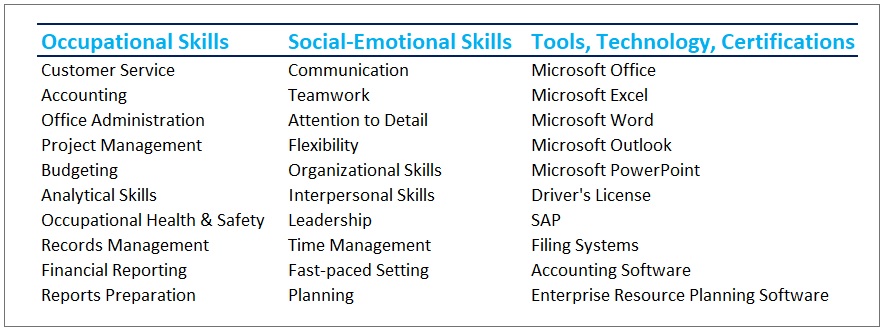
2 - Engineering, Math, Science, and Information Technology
This category includes occupations in sciences, engineering, architecture, and information technology.
These occupations require post-secondary education in an appropriate scientific or technical discipline. Advancement from technical to professional occupations usually requires additional education.
Social-emotional skills are in high demand in this category with 94% of job postings identifying these skills. Occupation-specific skills were identified in 88% of job postings. Technologies also have the strongest demand in this category with 69% of job postings looking for these skills. Certificates are in moderate demand with 24% of postings identifying them. Tools do not figure strongly in this group. Below are the top skills for their skill categories.
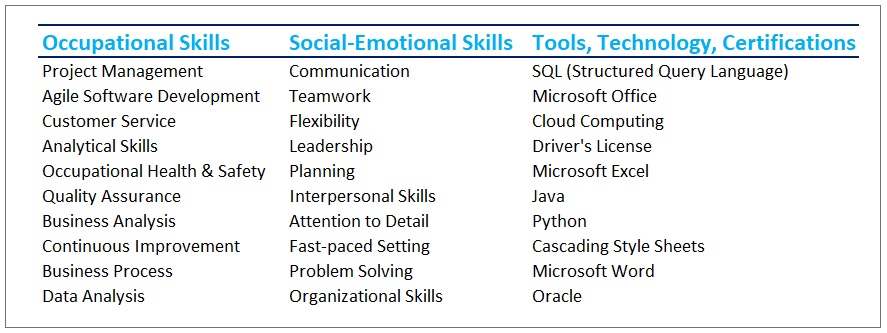
3 - Health
This category includes occupations that provide health care services directly to patients and those that provide technical support to medical staff.
Advancement from medical and dental technical roles to professional occupations requires additional formal education. Advancement to supervisory positions requires experience in the occupations supervised. Support occupations in health are usually supplied by short training programs specific to the support area.
Social-emotional skills are in high demand in this category with 89% of job postings identifying these skills. Occupation-specific skills were identified in 73% of job postings. Technologies have lower demand in this category with only 18% of job postings looking for these skills. Certificates have the highest demand in this category with 59% of postings identifying them. Tools do not figure strongly in this group. Below are the top skills for their skill categories.
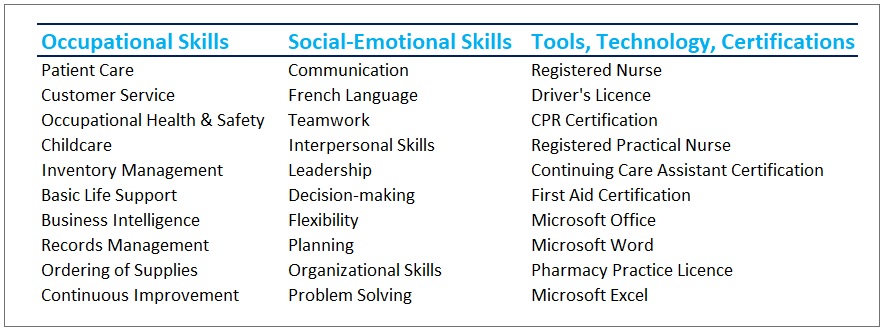
4 - Education, Law, and Social, Community, and Government Services
Occupations in this category are concerned with law, teaching, counseling, conducting social science research, developing government policy, and administering government and other programs. Religious services and leadership roles are included in this category.
These occupations usually require the completion of a related post-secondary program. Individuals who work as paralegals, social service workers, or educators and instructors who are not part of the elementary, secondary, or post-secondary school system are usually required to complete additional formal education to advance to professional occupations.
Social-emotional skills are in high demand in this category with 92% of job postings identifying these skills. Occupation-specific skills were identified in 64% of job postings – the second lowest of all categories. Technologies have a lower demand in this category with only 21% of job postings looking for these skills. Certificates have a moderate demand with 38% of postings identifying them. Tools do not figure strongly in this group. Below are the top skills for their skill categories.
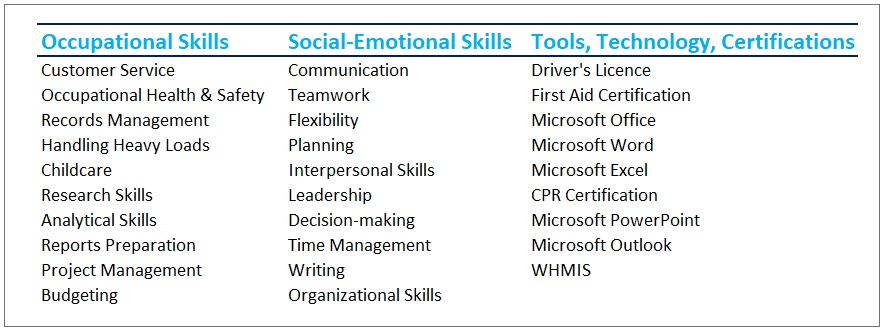
5 - Art, Culture, Recreation and Sport
This category includes occupations in art and culture, including the performing arts, film and video, broadcasting, journalism, writing, creative design, libraries, and museums.
Social-emotional skills are in high demand in this category with 93% of job postings identifying these skills. Occupation-specific skills were identified in 68% of job postings. Technologies have a moderate demand in this category with 28% of job postings looking for these skills. Certificates have a moderate demand with 24% of postings identifying them. Tools do not figure strongly in this group. Below are the top skills for their skill categories.
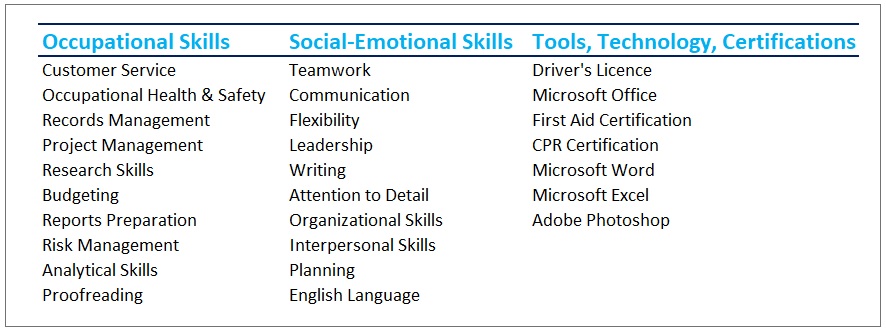
6 - Sales and Service
This category contains retail and wholesale sales occupations and customer and personal service occupations related to a wide range of industries like as accommodation and food services, travel, tourism and cleaning services.
Sales and service occupations can be linked, for the most part, to formal post-secondary or occupation-specific training programs. Others are characterized by periods of formal on-the-job training. Apprenticeship training is available for some specialized service occupations. Advancement from sales and service occupations to positions of increased responsibility, or supervision, usually requires occupational experience and may require completion of related training programs.
Social-emotional skills are in high demand in this category with 90% of job postings identifying these skills. Occupation-specific skills were identified in 86% of job postings. Technologies have a lower demand in this category with 19% of job postings looking for these skills. Certificates have a lower demand with 15% of postings identifying them. Tools have a low demand with 11% of job postings requesting these skills. Below are the top skills for their skill categories.
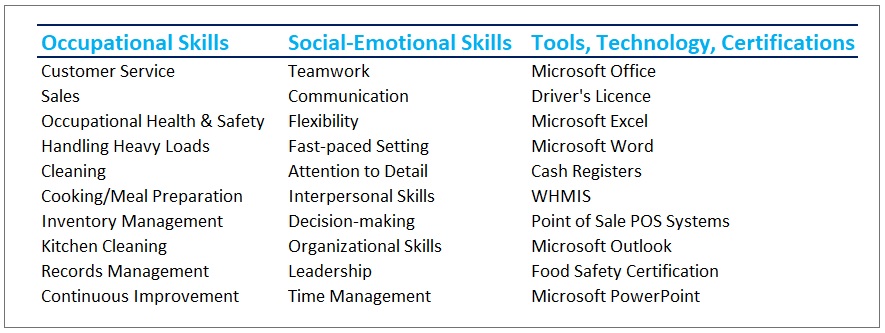
7 - Trades and Transportation
This category includes trades supervisors and contractors, construction and mechanical tradespersons, operators of transportation and heavy equipment, and trades helpers. These occupations are found in a wide range of industries, with many in the construction and transportation industries.
This category includes most of the trades, including all those related to the construction industry. Other occupations in this category usually require completion of college or vocational education programs combined with on-the-job training. Helpers get training on the job site. Advancement to supervisory positions or self-employed contractor status is possible with experience. There is limited mobility or transferability of skills among occupations in this category due to specific apprenticeship, training, and licensing requirements for most occupations.
Social-emotional skills are in high demand in this category with 89% of job postings identifying these skills. Occupation-specific skills were identified in 80% of job postings. Technologies have a lower demand in this category with 15% of job postings looking for these skills. Certificates have the second-highest demand with 48% of postings identifying them. Tools have the highest demand of all categories with 34% of job postings requesting these skills. Below are the top skills for their skill categories.
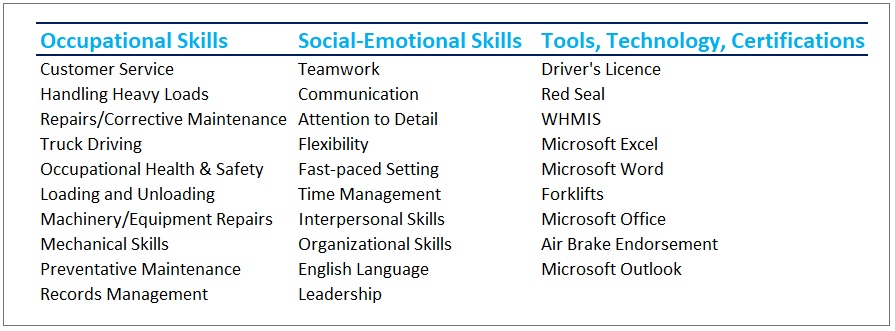
8 - Farming, Fishing, Forestry and Mining
These occupations include supervisors and equipment operators in the natural resource-based sectors of mining, oil and gas production, forestry and logging, agriculture, horticulture, and fishing. Most occupations in this category are industry-specific and do not occur outside of the primary resources industries.
Occupations within this category generally require completion of college or vocational education programs. Some of these occupations, however, are characterized by on-the-job training and progression through experience.
Social-emotional skills are in high demand in this category with 95% of job postings identifying these skills. Occupation-specific skills were identified in only 61% of job postings, the lowest of all groups. Technologies do not figure strongly in this group. Certificates have a moderate demand with 29% of postings identifying them. Tools have a small demand with 18% of job postings requesting these skills. Below are the top skills for their skill categories.

9 - Manufacturing and Utilities
This category contains supervisory, production, and labouring occupations in manufacturing, processing, and utilities. Occupations in this category are characterized by either technical training, internal progression, or on-the-job training.
Process control occupations in this category are increasingly technical and post-secondary training is usually required. For many occupations in this category, workers typically start out as labourers and advance to machine operation occupations through experience. Advancement to supervisory positions requires experience in the occupations supervised. Mobility in some of these occupations may be limited by seniority provisions of collective agreements or may require additional training.
Social-emotional skills are in high demand in this category with 92% of job postings identifying these skills. Occupation-specific skills were identified in 73% of job postings. Technologies have a low demand at 13% of all postings. Certificates have some demand with 19% of postings identifying them. Tools have the second largest demand with 30% of job postings requesting these skills. Below are the top skills for their skill categories.
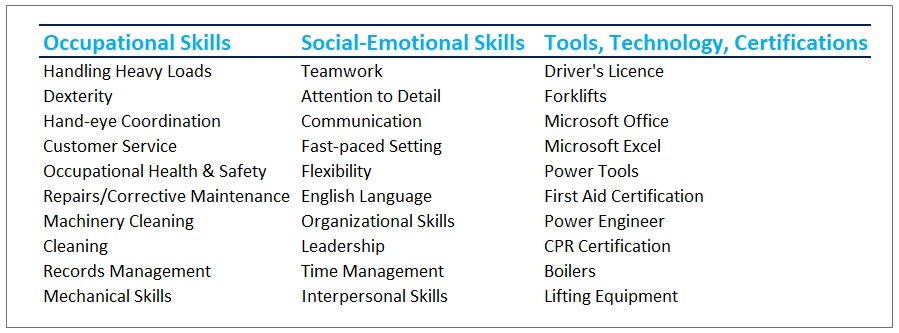
Source: Vicinity Jobs. Skills and Certifications by Level 1 Occupational Group. January 1, 2022 – December 31, 2022.